|
|
Hearing Westside traffic 'concerns,' city posts bike-race survey
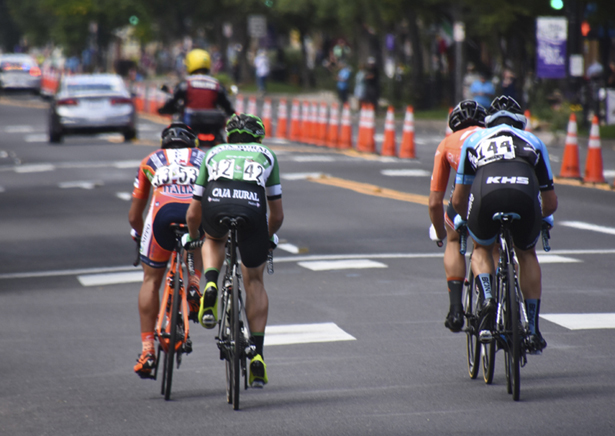 A view west along Colorado Avenue in Old
Colorado City early in the
men's race: In the foreground is a short-lived breakaway of four cyclists; in the
background are spectators
lining the north side of the avenue in front of Bancroft Park. The motorcyclist and
cars driving ahead of
the riders are support/security vehicles.
A view west along Colorado Avenue in Old
Colorado City early in the
men's race: In the foreground is a short-lived breakaway of four cyclists; in the
background are spectators
lining the north side of the avenue in front of Bancroft Park. The motorcyclist and
cars driving ahead of
the riders are support/security vehicles.
Westside Pioneer photo
|
However, Waters did allow that “events like these are going to have traffic issues” and that the city had heard “some calls of concern” from the Old Colorado City area, where numerous streets were closed for the eight hours that the event was going on.
In response, the city has set up an online survey to which anyone can post their thoughts. The survey is at this link.
Among the questions are "How were you impacted?" and "Do you have any suggestions to make future events more successful?" Waters said that no deadline for responses has been set.
On the Westside, event-related problems included slow-moving - sometimes confused or frustrated - motorists
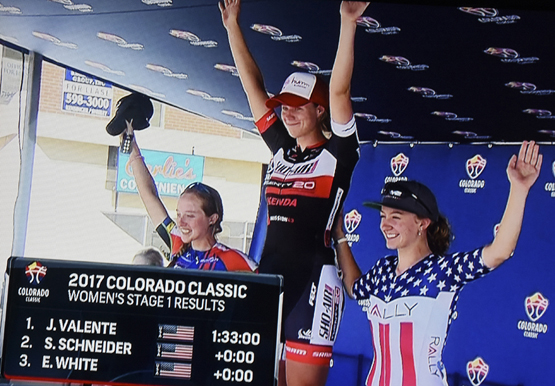 The top three in the Stage 1 women's race
celebrate on the platform
shortly
after the finish. Winner Jenn Valente is in the middle. At left is Skylar Schneider;
at right is Emma White.
The top three in the Stage 1 women's race
celebrate on the platform
shortly
after the finish. Winner Jenn Valente is in the middle. At left is Skylar Schneider;
at right is Emma White.
Westside Pioneer photo from NBC Sports
Network
|
In the weeks before the race, several Westsiders led by neighborhood advocate Welling Clark asked to be involved in the planning for any future events like the Classic. On the day of the event, he said that some of the race's traffic issues resulted from "really poor communication."
Waters explained that the survey will help city officials look for better ways to manage such events in the future. “We want to evaluate how it went, what went well and what we can improve on,” he said.
With a women's race in the morning and men's in the afternoon, Stage 1 had a total of eight identical 15- mile “laps” that took in the Colorado Springs downtown and Westside. Included in the route were Old Colorado City, some older neighborhoods and the Garden of the Gods.
Major closed streets between 9 a.m. and 5 p.m. were Colorado Avenue west to 31st Street, 30th Street from Colorado to Fontmore, Mesa Road north of Fillmore/Fontmore, Pikes Peak Avenue from Ridge to 30th, and 31st between Colorado and Pikes Peak Avenue. Uintah and King were open, but westbound traffic was stopped short of 30th Street. The Garden itself was closed to vehicles from midnight to 5 p.m. on the day of the race.
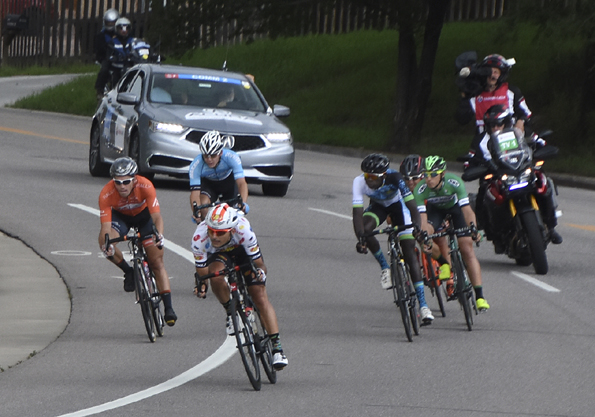 The lead group of riders during the second lap
of the six-lap Colorado
Classic Stage 1 men's race lean into the curve on Fontmore Road shortly before a
left onto 30th Street. At
the time, the six had about a three-minute lead on the other riders, but the pack
("peloton") eventually caught up.
The lead group of riders during the second lap
of the six-lap Colorado
Classic Stage 1 men's race lean into the curve on Fontmore Road shortly before a
left onto 30th Street. At
the time, the six had about a three-minute lead on the other riders, but the pack
("peloton") eventually caught up.
Westside Pioneer photo
|
Waters said he did not know this had happened or what information CDOT may have been acting on.
Combining scenery with difficult climbs in and near the Garden of the Gods, the 15-mile lap was identical to the one riders used three years ago for a stage of the USA Pro Challenge. It combines scenery with difficult climbs in and near the Garden of the Gods.
Lap repetition is the design difference between the Challenge and the Classic. During the five years the Challenge was held in Colorado, riders chiefly pedaled from town to town for a stage.
Repeated laps in a single community costs less money for traffic control and focuses the cyclists where the most fans are, Doug Martin of Colorado Sports Corp, the Stage 1 organizer, previously explained. “It's a lot better from a spectator standpoint,” he told the Westside Pioneer.
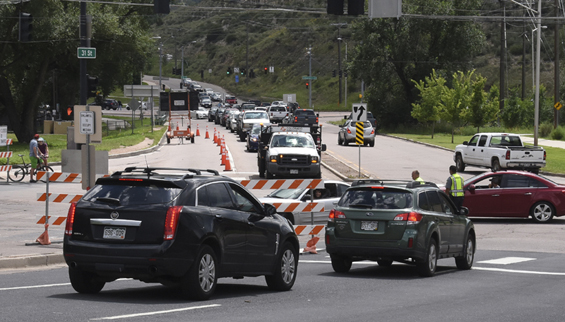 A confused motorist at Colorado Avenue and
31st Street had to back up
and turn around after evidently missing the closure on 31st between Colorado and
Pikes Peak avenues
during
the Colorado Classic. Photo looks south.
A confused motorist at Colorado Avenue and
31st Street had to back up
and turn around after evidently missing the closure on 31st between Colorado and
Pikes Peak avenues
during
the Colorado Classic. Photo looks south.
Westside Pioneer file photo
|
About 160 riders (90 male, 70 female) participated. One of the men, Rigoberto Uran, had finished second in the Tour de France earlier this summer.
In both the Stage 1 races, despite the distances (38.3 miles for the women and 93.5 for the men), the finish involved a pack with a few dozen riders sprinting to the line and the winner edging out the competition by less than the width of a wheel.
The men's race was spiced by a heavy downpour on the final lap. This was the part that was on national TV; the broadcast included shots of a flooded downtown intersection and disappointed remarks from the announcer that Pikes Peak was covered by clouds.
In all, the Colorado Classic schedule called for four stages on successive days. The second stage was in Breckenridge and the third and fourth in the Denver area the weekend of Aug. 12-13. The overall men/women winners (Manuel Senni, men; Sara Poidevin, women) were those with the lowest times for all four stages.
Westside Pioneer/press release
(Posted 8/11/17, updated 8/13/17;
Community:
Groups/Clubs)
|
Would you like to respond to this article? The Westside Pioneer welcomes letters at editor@westsidepioneer.com. (Click here for letter-writing criteria.)
 Roughly two miles from the downtown start,
more than half the 90 male
riders mass across the 2300 block of Colorado Avenue in the first lap of Stage 1
of the Colorado Classic
bicycle race Aug. 10. The avenue was closed for the event between the downtown
and 30th Street. The cone
on the left was one among a long row down the center of the avenue. This
demarcation was needed because
cyclists went both westbound (above) and eastbound on the avenue as part of a
repeated 15-mile lap (six for the men, two for the women).
Roughly two miles from the downtown start,
more than half the 90 male
riders mass across the 2300 block of Colorado Avenue in the first lap of Stage 1
of the Colorado Classic
bicycle race Aug. 10. The avenue was closed for the event between the downtown
and 30th Street. The cone
on the left was one among a long row down the center of the avenue. This
demarcation was needed because
cyclists went both westbound (above) and eastbound on the avenue as part of a
repeated 15-mile lap (six for the men, two for the women).
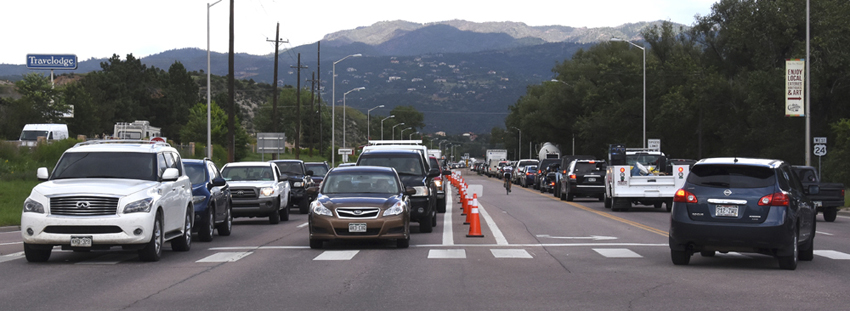 In an ironical traffic moment during the
Colorado Classic Aug. 10, a
citizen bicyclist (middle right) rolls westbound through the blocked-off eastbound
left-turn lane of
Highway
24 at 26th Street and past the barely moving cars. Also coned off was the
westbound right turn lane. The
effect was to discourage access to northbound 26th Street, which contradicted
pre-race information that
motorized vehicles could travel
between the highway and the south side of Colorado Avenue during the event.
Similar
scenarios also played out at 8th and 21st streets, according to reports.
In an ironical traffic moment during the
Colorado Classic Aug. 10, a
citizen bicyclist (middle right) rolls westbound through the blocked-off eastbound
left-turn lane of
Highway
24 at 26th Street and past the barely moving cars. Also coned off was the
westbound right turn lane. The
effect was to discourage access to northbound 26th Street, which contradicted
pre-race information that
motorized vehicles could travel
between the highway and the south side of Colorado Avenue during the event.
Similar
scenarios also played out at 8th and 21st streets, according to reports.
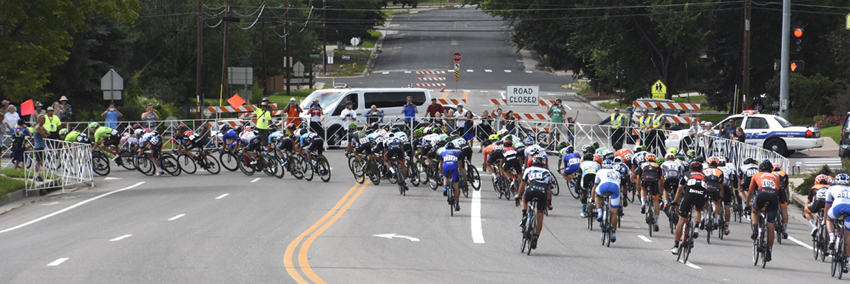 Many of the riders in the men's race rip around
the curve from Fontmore
Road to go south on 30th Street. This was part of a downhill section after the turn
from southbound Mesa
Road onto Fontmore.
Many of the riders in the men's race rip around
the curve from Fontmore
Road to go south on 30th Street. This was part of a downhill section after the turn
from southbound Mesa
Road onto Fontmore.